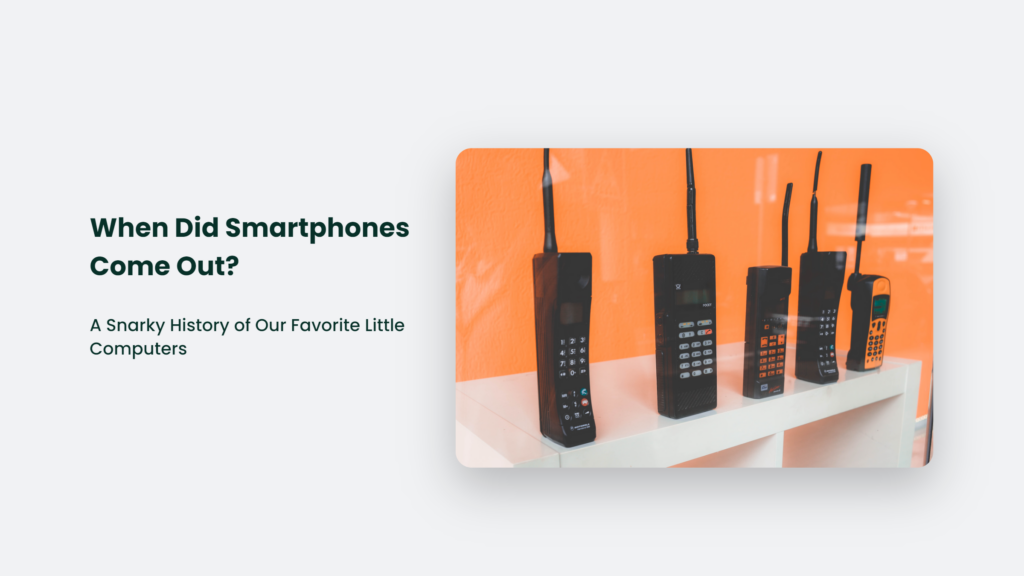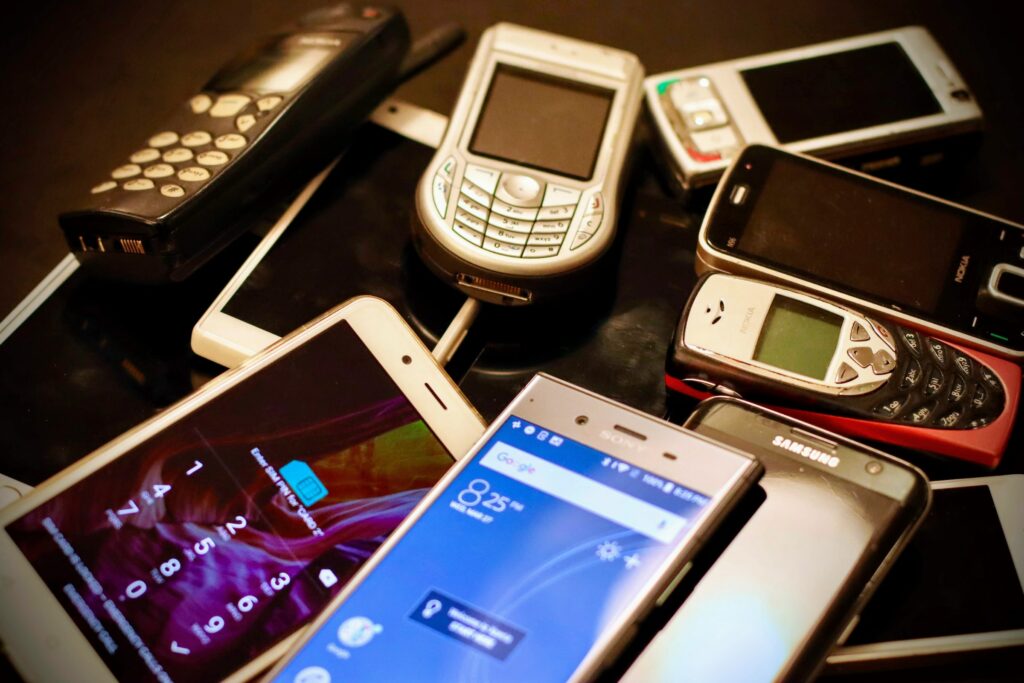Raise your hand if you remember life before smartphones. Yeah, me neither. These little pocket computers seem to have been around forever, but they’re a pretty recent invention.
Let’s hop in our DeLorean and set the flux capacitor to 1992 when the first true smartphone was invented. Smartphones didn’t just appear out of nowhere like a Snapchat filter; they evolved over many decades from humble beginnings as bulky “car phones” and overpriced yuppie status symbols.
Grab your best flannel shirt and Doc Martens because we’re going on a radical trip down memory lane to explore the origins of the smartphone!

When Did Smartphones Come Out?
The Dark Ages: 1973 to 1992
Once upon a time, all phones were attached to walls. It was a barbaric era. Then, in 1973, a sorcerer named Martin Cooper at Motorola whipped up a prototype mobile phone with his cauldron. Cooper made the first-ever cell phone call while standing on a New York City street, probably yelling, “Can you hear me now?”
A decade later, in 1983, Motorola introduced the DynaTAC 8000X, a real handheld wireless phone and the first cell phone approved by the FCC. This bad boy was nicknamed “The Brick” for good reason – it weighed 2 pounds (the same as 8 modern iPhones) and cost nearly $4,000.But the DynaTAC had one fatal flaw: it could only hold a charge for 30 minutes.
So, if you wanted to use your phone for longer than half an hour, you had to carry around a briefcase of backup batteries like a crazy person. Ah, the good ol’ days!
The 80s gave us parachute pants, big hair, and mobile phones only Gordon Gekko could afford. But on the horizon, a new age was dawning…
The Middle Ages: 1992 to 2007
In 1992, IBM engineer Frank Canova realized technology was finally small enough to create a handheld computer with wireless calling capabilities. Eureka! Canova built a prototype of the world’s first smartphone, code-named “Simon.”Simon was unveiled at a tech conference that year but wasn’t available to consumers until 1994. For $1,100, early adopters got a touchscreen, apps, email, fax capabilities, and more. Simon boldly went where no wireless phone had gone before!
Other geeky gadgets like the PalmPilot PDA soon followed, merging personal organizers with primitive wireless data networks like 2G. But the real action started around 2000 when mobile phones finally gained access to the magical world of the Internet via 3G networks.
Unfortunately, data plans were exorbitantly expensive in the early 2000s. So, only business bigwigs could afford to surf the web or check email on their phones without going bankrupt.
By 2007, most mobile phones had evolved into “smart” devices with QWERTY keyboards, touchscreens, web access, cameras, music players, and PDA functions. High-end brands like Palm, BlackBerry, and Windows Mobile catered mainly to enterprise users.
But that all changed in January 2007 when a little company called Apple unveiled the Jesus Phone.
The Renaissance: 2007 to Present
When Steve Jobs announced the first iPhone in 2007, it was a huge leap forward from anything else on the market. The iPhone had a slick touchscreen with pinch-to-zoom, visual voicemail, web browsing, Google Maps, YouTube, email, and an iPod.Most importantly, it let users access the full Internet for the first time, not the crippled mobile web we’d been spoon-fed until then. The smartphone became more than just a wireless phone – a mini-computer with endless possibilities.
When Apple’s iPhone was sold in June 2007, eager customers lined up around blocks. The iPhone’s slick design and intuitive interface made everything else seem antiquated. Riding this wave of hype, Apple sold over 6 million iPhones in the first year alone.
Of course, Apple’s success attracted some copycat competitors. Most notably, Google partnered with phone makers like HTC to launch Android phones in 2008. Android’s open-source operating system lets anyone build phones without paying Apple’s steep fees.
The friendly rivalry between iOS and Android drove rapid innovation throughout the late 2000s and early 2010s. Everything about smartphones got smarter, especially their price tags. As Apple and Samsung battled for market share, prices dropped low enough for the average person to get a smartphone.
By 2013, over 1 billion people worldwide owned a nifty slab of glass and circuitry in their pocket. Today, an estimated 3.5 billion people have smartphones – nearly half the population of Earth! We truly live in the future.
Nowadays, smartphones are ubiquitous in most countries. 5G networks provide lightning-fast speeds. AI-powered cameras snap professional-grade photos. And edge-to-edge OLED displays immerse us in movies and games.
It’s hard to imagine how we ever survived without these magical slices of technology!
The Timeline of Smartphone History
Let’s recap the evolution of smartphones from ancient history to the advanced supercomputers in our pockets:
1973 – Martin Cooper at Motorola makes the first cell phone call on a 2-pound prototype mobile phone.
1983 – The Motorola DynaTAC 8000X became the first commercially available cell phone. It costs $4,000 and can hold a charge for 30 minutes.
1992 – IBM engineer Frank Canova builds the first smartphone prototype, Simon, which is unveiled at a tech conference.
1994 – Simon goes on sale for $1,100 as the first touchscreen smartphone with apps, email, fax, and more.2000 – Mobile phones get wireless Internet access for the first time via 3G networks, but data is expensive.
2007 – Apple releases the first iPhone, launching the smartphone revolution with its full Internet, apps, and slick design.
2008 – Google releases the T-Mobile G1, the first phone running its Android operating system, competing with the iPhone.2013 – Global smartphone penetration reaches 1 billion users. Prices drop as Apple and Samsung fight for market share.
Today – Over 3.5 billion people worldwide own smartphones with advanced features like 5G, AI cameras, and edge-to-edge displays.
The Future of Smartphones
It’s incredible how far we’ve come from the days of Gordon Gekko’s brick-sized DynaTAC. But if history teaches us anything, it’s that smartphone innovation is far from over.
Apple is rumoured to be developing an AR/VR headset to complement its phones. 5G networks will keep getting faster. AI assistants like Siri and Alexa will get exponentially smarter. And foldable displays could give us expandable screens that fit in our pockets.
But if I’ve learned one thing from following the history of technology, it’s that the most successful products are the ones that focus on people first – not just technical specs.
As smartphones get smarter, I hope Apple, Samsung, and other phone makers don’t lose sight of what really matters: how their devices improve our lives, not just blow our minds.
Because, at the end of the day, smartphones are just tools. It’s what we create with them that matters most. So here’s to the past and present innovators who made these marvellous mini-computers possible! Keep pushing the limits of what a smartphone can be.
Just don’t forget to look up from your screen now and then to enjoy the view. We’ve come a long way since 1992, but some things never change – like the wonder of the world around us.
If you’ll excuse me, I must return to playing Candy Crush.
Frequently Asked Questions:
Who invented the first smartphone?
The first true smartphone is considered to be the IBM Simon, invented by IBM engineer Frank Canova in 1992. It launched commercially in 1994.
What was the first iPhone model?
The first iPhone was simply called “iPhone” and launched in 2007. It had a 3.5″ screen, up to 8GB of storage, and ran iOS 1.0.
When did Android phones first launch?
The first Android phone was the HTC Dream, released in October 2008. It introduced Android 1.0 to the world.
The Bottom Line:
The evolution of the smartphone has been a fascinating journey. These devices have gone from bulky, expensive status symbols to ubiquitous pocket computers in just a few decades.
- The first true smartphone, IBM’s Simon, emerged in 1992 and introduced novel concepts like touchscreens and downloadable apps.
- Apple’s iPhone in 2007 marked the real turning point that made smartphones mainstream. Its full Internet access, multi-touch interface, and app ecosystem changed what people expected from phones.
- Android’s launch in 2008 cemented smartphone popularity by providing more affordable options. The iOS vs Android rivalry drove rapid innovation in the late 2000s.
- Prices dropped as technology improved, allowing over 3.5 billion people globally to own smartphones today.
While early smartphones were mainly for business users, today, these devices are integral to modern life. We rely on them for work, entertainment, communication, and much more.
It’s incredible to think where we might be in another 10 or 20 years. If the past is any indicator, future smartphones will keep getting smarter with new capabilities like AR/VR, foldable displays, 5G, and AI.
But no matter how advanced the tech gets, smartphones are just tools. It’s what we do with them that matters most. The future lies in using smartphones as a means, not an end, to improve our lives and connect.




